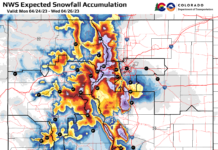by Marissa Lorenz
The Grand County Board of County Commissioners (BOCC) recently reviewed the final Abstract of Assessment for 2019, presented by Grand County Assessor Tom Weydert. The assessment provides the overall property values that may be taxed by the County and other taxing districts, such as the Grand County Library District, the West and East Grand School Districts, the Kremmling Hospital District, and more. The outlook was positive for local taxing entities, as the total taxable value increased around 21 percent or $130 billion, going from $663 billion in 2018 to $796 billion for 2019. What it means for property owners, however, is that they will see their taxes also increase, as the value of their property increases.
Weydert explained the complexity of the assessment process, pointing out that there are approximately 27,000 property accounts in Grand County that must each be valued according to their proper classification. “I want to express what a tremendous job our assessors have done,” he commented. “The County and our special districts count on these tax dollars. And property owners count on what we do to be fair and equitable to everyone.”
The major land classification categories are vacant, residential, commercial, industrial, agricultural, natural resources, producing mines, and public utilities, each being broken down into numerous sub-classifications. Nearly all categories saw an increase in value, with total residential properties increasing 23 percent, going from $388,421,550 in 2018 to $504,032,110 in 2019, and commercial properties going from $89,991,850 to $103,161,710 for a 13 percent year-over-year increase.
Of note to the BOCC was the fact that industrial values have decreased nearly 40 percent, dropping from $40,301,420 in 2018 to $29,037,350 this year. Commissioner Kristin Manguso asked about the dip and Weydert explained that it was mostly due to current and planned land uses related to Freeport McMoRan’s Henderson molybdenum mill. Valuation of the mill has been a topic of contention in recent years, as the County agreed to move from a 5-year valuation window to a 3-year window, leading some citizens to express concern over potential lost revenue. In spite of some land-use changes, production has increased this year, according to Weydert.
Further affecting the assessment and individual taxes is the fact that 2019 is a revaluation year. Per State legislation, all Colorado property is revalued every odd-numbered year. The 2017-2018 assessment percentage for improved residential properties (meaning residential land with a structure on it) was 7.2 percent. Thus a $240,000 home in Kremmling would have been assessed at $17,280 in 2017 and 2018, and this is the number that would be used to calculate property taxes owed. Most other properties, including vacant land, were assessed at 29 percent.
Appraisal sales data for a given 18-month period prior to the revaluation year is used by the State to determine the assessment percentage to be “applied to the actual value of your property before property taxes are calculated,” according to the Grand County Assessor’s Office web-page. Sales information from the 18-month period from January 1, 2017, to June 30, 2018, was compiled for the 2019 revaluation.
Data collected by the Grand County Board of Realtors shows a marked increase in a number of sales and average sale price in that period, compared to earlier years. Just looking at single-family home sales will show that, while there was a 2 percent drop in average sales price across the county between 2016 and 2015, there was a 23 percent increase between 2016 and 2017. That number continued to go up in 2018, with an overall average sales increase of 10 percent over 2017 single-family home sales. Those numbers do vary by community, but all Grand County communities showed an increase in average sales price in 2017 and only Grand Lake and out of county sales did not show growth in 2018.
The Colorado legislature is the governing body responsible for determining the assessment percentage every other year. In June of this year, the Colorado legislature signed into law a bill [SB 19-255] that reduces the Residential Assessment Rate (RAR) to 7.15 percent for 2019 and 2020. It is the combination of increased property values across the state and the decreased assessment percentage that determines the impact on local shares of taxes for taxing districts, such as school districts, an equation that still bodes well for those entities. For example, a statement released by the Legislative Council Staff indicates that the local share for school finance will increase by an estimated $107 million in 2019-2020, even with the reduced 7.15 percent assessment rate.
In all, most of our local and state services are funded by taxes, with property tax revenue being a major source of funds. As the State’s economy continues to grow, with both population numbers and property values increasing, property owners will continue to see increases in their taxes as well, though how much is limited by Colorado’s constitutional TABOR Amendment. The payback will hopefully come in equally increased or bettered services, provided through funding for school districts and fire districts, local and state governments, and more.








